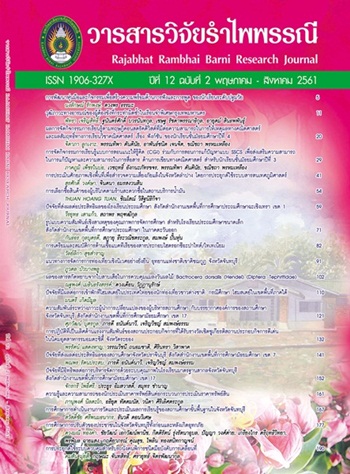การเตรียมและสมบัติการต้านเชื้อแบคทีเรียของสารประกอบไฮดรอกซีอะปาไทต์/ไทเทเนียม
Main Article Content
บทคัดย่อ
สารประกอบไฮดรอกซีอะปาไทต์/ไทเทเนียม (HAP/Ti) ถูกเตรียมจาก Ti4+ ที่มีความเข้มข้น XTi = 0.15, 0.2 และ 0.25 เมื่อ XTi = Ti/(Ca+Ti) โดยสารประกอบ HAP/Ti ถูกหาลักษณะเฉพาะด้วยฟูเรียทรานฟอร์มอินฟราเรด สเปกโตรสโครปี เอ็กเรย์ดิฟเฟรคชัน กล้องจุลทรรศน์อิเล็กตรอนแบบส่องกราดและทดสอบการต้านเชื้อแบคทีเรีย การต้านเชื้อแบคทีเรียทำการทดสอบโดยกรองสารละลายที่มีเชื้อแบคทีเรียแขวนลอยอยู่ด้วยผ้าฝ้ายที่ถูกชุบเพื่อให้มีการแทรกตัวของสารประกอบ HAP/Ti อยู่บนผ้าฝ้าย จากผลการทดลองพบว่า แบคทีเรียประมาณร้อยละ 95-98 ถูกกำจัดออก ไปภายใต้แสงยูวีที่ถูกกรองด้วยผ้ากรอง 2 ชั้น และยังพบว่าเมื่อนำสารประกอบ HAP/Ti ใส่ลงในสารละลายที่มีเชื้อแบคทีเรียพร้อมกับฉายแสงยูวีเป็นเวลา 60 นาที มีร้อยละการฆ่าเชื้อแบคทีเรียอยู่ที่ประมาณร้อยละ 78-82
Article Details
ประเภทบทความ
บทความวิจัย
เอกสารอ้างอิง
1. Anmin, H., Ming, L., Chengkang, C. and Dali, M. (2007). Preparation and Characterization of a Titanium-Substituted Hydroxyapatite Photocatalyst. Journal of Molecular Catalysis A: Chemical. 267: 79–85.
2. Anmin, H., Tong, L., Ming, L., Chengkang, C., Huiqin, L. and Dali, M. (2006). Preparation of nanocrystals hydroxyapatite/TiO2 compound by hydrothermal treatment. Applied Catalysis B: Environmental. 63: 41–44.
3. Beranek, R., & Kisch, H. (2008). Tuning the Optical and Photoelectrochemical Properties of Surface-Modified TiO2. Photochemical & Photobiological Sciences, 7(1), 40-48.
4. Jokanovic, V., Izvonar, D., Dramicanin, M. D., Jokanovic, B., Zivojinovic, V., Markovic, D. and Dacic, B. (2006). Hydrothermal Synthesis and Nanostructure of Carbonated Calcium Hydroxyapatite, Journal of Materials Science: Materials in Medicine. 17: 539-546.
5. Li, Q., Mahendra, S., Lyon, D. Y., Brunet, L., Liga, M. V., Li, D. and Alvarez, P. J. J. (2008). Antimicrobial Nanomaterials for Water Disinfection and Microbial Control: Potential Applications and Implications. Water research. 42: 4591-4602.
6. Manivannan, A., Glaspell, G,. and Dutta, P. (2008). Synthesis of Nanocrystalline TiO2 Particles and Their Structural Characteristics. Journal of Cluster Science. 19, 391–399.
7. Nathanael, A. J., Mangalaraj, D., Chen, P. C. and Ponpandian, N. (2010). Mechanical and Photocatalytic Properties of Hydroxyapatite/Titania Nanocomposites Prepared by Combined High Gravity and Hydrothermal Process. Composites Science and Technology. 70: 419–426.
8. Neumann, M. and Epple M. (2006). Composites of Calcium Phosphate and Polymers as Bone Substitution Materials. European Journal of Trauma. 2: 125-131.
9. Nishikawa, H. (2003). Surface Changes and Radical Formation on Hydroxyapatite by UV Irradiation for Inducing Photocatalystic Activation. Journal of Molecular Catalysis A: Chemical. 206: 331-338.
10. Piantone, P., Bodénan, F., Derie, R., and Depelsenaire, G. (2003). Monitoring the Stabilization of Municipal Solid Waste Incineration Fly Ash by Phosphation: Mineralogical and Balance Approach. Waste Management. 23: 225-243.
11. Tsukada, M., Wakamura, M., Yoshida, N. and Watanabe, T. (2011). Band Gap and Photocatalytic Properties of Ti-Substituted Hydroxyapatite: Comparison with Anatase-TiO2. Journal of Molecular Catalysis A: Chemical. 338: 18-23.
12. Wakamura, M., Hashimoto K. and Watanabe T. (2003). Photocatalysis by Calcium Hydroxyapatite Modified with Ti(IV): Albumin Decomposition and Bactericidal Effect. Langmuir. 19: 3428-3431.
13. Yang, L., Ning, X. Chen, K. and Zhou, H. (2007). Preparation and Properties of Hydroxyapatite Filters for Microbial Filtration. Ceramics International. 33: 483–489.
2. Anmin, H., Tong, L., Ming, L., Chengkang, C., Huiqin, L. and Dali, M. (2006). Preparation of nanocrystals hydroxyapatite/TiO2 compound by hydrothermal treatment. Applied Catalysis B: Environmental. 63: 41–44.
3. Beranek, R., & Kisch, H. (2008). Tuning the Optical and Photoelectrochemical Properties of Surface-Modified TiO2. Photochemical & Photobiological Sciences, 7(1), 40-48.
4. Jokanovic, V., Izvonar, D., Dramicanin, M. D., Jokanovic, B., Zivojinovic, V., Markovic, D. and Dacic, B. (2006). Hydrothermal Synthesis and Nanostructure of Carbonated Calcium Hydroxyapatite, Journal of Materials Science: Materials in Medicine. 17: 539-546.
5. Li, Q., Mahendra, S., Lyon, D. Y., Brunet, L., Liga, M. V., Li, D. and Alvarez, P. J. J. (2008). Antimicrobial Nanomaterials for Water Disinfection and Microbial Control: Potential Applications and Implications. Water research. 42: 4591-4602.
6. Manivannan, A., Glaspell, G,. and Dutta, P. (2008). Synthesis of Nanocrystalline TiO2 Particles and Their Structural Characteristics. Journal of Cluster Science. 19, 391–399.
7. Nathanael, A. J., Mangalaraj, D., Chen, P. C. and Ponpandian, N. (2010). Mechanical and Photocatalytic Properties of Hydroxyapatite/Titania Nanocomposites Prepared by Combined High Gravity and Hydrothermal Process. Composites Science and Technology. 70: 419–426.
8. Neumann, M. and Epple M. (2006). Composites of Calcium Phosphate and Polymers as Bone Substitution Materials. European Journal of Trauma. 2: 125-131.
9. Nishikawa, H. (2003). Surface Changes and Radical Formation on Hydroxyapatite by UV Irradiation for Inducing Photocatalystic Activation. Journal of Molecular Catalysis A: Chemical. 206: 331-338.
10. Piantone, P., Bodénan, F., Derie, R., and Depelsenaire, G. (2003). Monitoring the Stabilization of Municipal Solid Waste Incineration Fly Ash by Phosphation: Mineralogical and Balance Approach. Waste Management. 23: 225-243.
11. Tsukada, M., Wakamura, M., Yoshida, N. and Watanabe, T. (2011). Band Gap and Photocatalytic Properties of Ti-Substituted Hydroxyapatite: Comparison with Anatase-TiO2. Journal of Molecular Catalysis A: Chemical. 338: 18-23.
12. Wakamura, M., Hashimoto K. and Watanabe T. (2003). Photocatalysis by Calcium Hydroxyapatite Modified with Ti(IV): Albumin Decomposition and Bactericidal Effect. Langmuir. 19: 3428-3431.
13. Yang, L., Ning, X. Chen, K. and Zhou, H. (2007). Preparation and Properties of Hydroxyapatite Filters for Microbial Filtration. Ceramics International. 33: 483–489.


